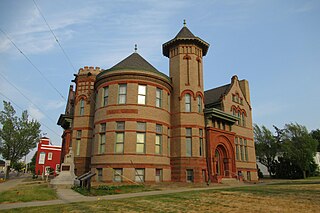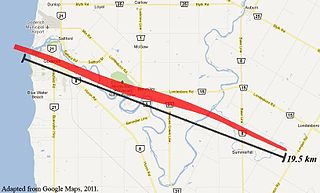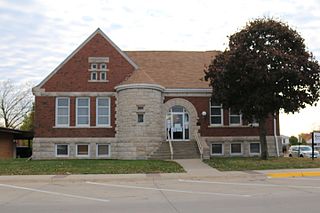
Port Huron is a city in the U.S. state of Michigan and the county seat of St. Clair County. The population was 28,983 at the 2020 census. The city is bordered on the west by Port Huron Township, but the two are administered autonomously.

Woodstock is a city in Southwestern Ontario, Canada. The city has a population of 46,705 according to the 2016 Canadian census. Woodstock is the seat of Oxford County, at the head of the Thames River, approximately 128 km from Toronto, and 43 km from London, Ontario. The city is known as the Dairy Capital of Canada and promotes itself as "The Friendly City".

Wingham is a community located in the municipality of North Huron, Ontario, Canada, which is located in Huron County. Wingham became part of North Huron in 2001 when the Ontario government imposed amalgamation on the former township of East Wawanosh, the village of Blyth, and the town of Wingham.

Goderich is a town in the Canadian province of Ontario and is the county seat of Huron County. The town was founded by John Galt and William "Tiger" Dunlop of the Canada Company in 1827. First laid out in 1828, the town is named after Frederick John Robinson, 1st Viscount Goderich, who was prime minister of the United Kingdom at the time. It was incorporated as a town in 1850.

Vancouver Public Library (VPL) is the public library system for the city of Vancouver, British Columbia. In 2023, VPL had more than 4.6 million visits with patrons borrowing nearly 10.4 million items including: books, ebooks, CDs, DVDs, video games, newspapers and magazines. Across 21 locations and online, VPL serves over 236,000 active members and is the largest public library system in British Columbia.

The San Francisco Public Library is the public library system of the city and county of San Francisco. The Main Library is located at Civic Center, at 100 Larkin Street. The library system has won several awards, such as Library Journal's Library of the Year award in 2018. The library is well-funded due to the city's dedicated Library Preservation Fund that was established by a 1994 ballot measure. The Preservation Fund was renewed twice, by ballot measures in 2007 and 2022.

The Greater Victoria Public Library (GVPL) is a public library that serves Victoria, British Columbia and the surrounding area.

Forty Mile Point Light is a lighthouse in Presque Isle County near Hammond Bay on the western shore of Lake Huron in Rogers Township, Michigan USA.

Point Clark is a lakefront cottage community on Lake Huron, in the municipality of Huron-Kinloss, Ontario, Canada. It is approximately 15 kilometres south of Kincardine and 40 kilometres north of Goderich. Main streets include Huron Road and Lake Range Road. Point Clark is served by Highway 21 (Ontario). It is a cottage town, and has a rare Imperial Tower style lighthouse. There is a sandy beach and a small harbour with a boat ramp. There are two streams or rivers that run into Lake Huron around Point Clark: Clark Creek and Pine River. There is a separate harbour in the mouth of the Pine River. Amberley is just outside and to the south of Point Clark and Lucknow is to the south-east of Point Clark.

The Fresno County Public Library provides books, ebooks, music, movies, magazines, newspapers, reference assistance, wireless Internet access and a variety of other services at its 35 locations throughout Fresno County, California. The library system is headquartered in Fresno, at the Central Library.

The Carnegie Center is the main building in the Port Huron, Michigan museum system. The building was financed by a $40,000 donation from Pittsburgh philanthropist and steel entrepreneur Andrew Carnegie.

Point Clark Lighthouse is located in a beach community, Point Clark, Ontario, near a point that protrudes into Lake Huron. Built between 1855 and 1859 under the instructions of the Board of Works, Canada West, it is one of the few lighthouses on the Great Lakes to be made primarily from stone. It is one of the Imperial Towers, a group of six nearly identical towers built by contractor John Brown for the "Province of Canada" on Lake Huron and Georgian Bay, all completed by 1859. The location for the Point Clark lighthouse was selected to warn sailors of the shoals (sandbars) 2 miles (3.2 km) off the Lake Huron coast. It is still functioning as an automated light. A restoration that eventually exceeded $2.3 million started in 2011 and the facility reopened for tourism in June 2015.

The Doris Foley Library for Historical Research is a reference and research library in Nevada City, in Nevada County, California. Built in 1907, the Romanesque Revival style building is currently a branch of the Nevada County Library SystemArchived 2010-08-24 at the Wayback Machine.

The Adrian Public Library is a historic structure located at 110 East Church Street in downtown Adrian, Michigan. Originally used as a library, it was designated as a Michigan Historic Site on December 14, 1976, and later listed on the National Register of Historic Places on December 6, 1977. It is located within the Downtown Adrian Commercial Historic District and adjacent to the Adrian Engine House No. 1. Today, the building houses the Lenawee County Historical Society Museum.

The 2011 Goderich, Ontario tornado was an F3 tornado generated by an isolated supercell which unexpectedly tore across Huron County, Ontario, Canada on the afternoon of Sunday, August 21, 2011. Beginning as a tornadic waterspout over Lake Huron, the tornado ripped through the lakeside town of Goderich severely damaging the historic downtown and homes in the surrounding area. One person died and 37 more were injured as a result. This was the strongest tornado to hit Ontario in over fifteen years, since the April 20, 1996, tornado outbreak in Williamsford, Arthur, and Violet Hill.

The Cleo Rogers Memorial Library, also known as the Main Library, is the flagship library of the Bartholomew County Public Library system. It includes a branch in Hope, Indiana, and a bookmobile that serves the county. The building was designed by I. M. Pei & Partners and constructed by Dunlap & Company, completed in 1969, and dedicated in 1971. It is notable for its design of red brick with concrete details and its Library Plaza, an urban space punctuated by the sculpture, "Large Arch" by Henry Moore. It is named for Cleo Rogers (1905–1964) who was the county librarian for 28 years and assistant librarian for nine years.

The Former Mount Pleasant Public Library is a historic building located in Mount Pleasant, Iowa, United States. The library here was established in 1875. The community applied to Andrew Carnegie for a grant to build a new building, which was accepted on January 13, 1903. They were initially granted $10,000 and then were given a further $2,500. The Chicago architectural firm Patton & Miller designed the Romanesque Revival structure. They adapted Henry Hobson Richardson's Thomas Crane Public Library (1882) for this building. Unlike the Crane Library, this building is primarily brick with rough stone used for a short tower on the main facade and for the trim. It also features an asymmetrical grouping of intersecting gables. The building opened on Wednesday, February 22, 1905. An addition was built onto the rear of the building in 1926. It was designed by the Des Moines architectural firm of Dougher, Rich & Woodburn. The building was listed on the National Register of Historic Places in 1983. The library has subsequently moved to another facility and this building now houses a branch of Southeastern Community College.

The Griswold Civic Center Historic District is a small historic district containing eight civic and religious buildings, roughly bounded by Hubbard, Walnut, and Trowbridge Streets, in Allegan, Michigan. It was added to the National Register of Historic Places in 1987.

Clinton Branch is the local branch of the Huron County Library in Clinton, Ontario.



















